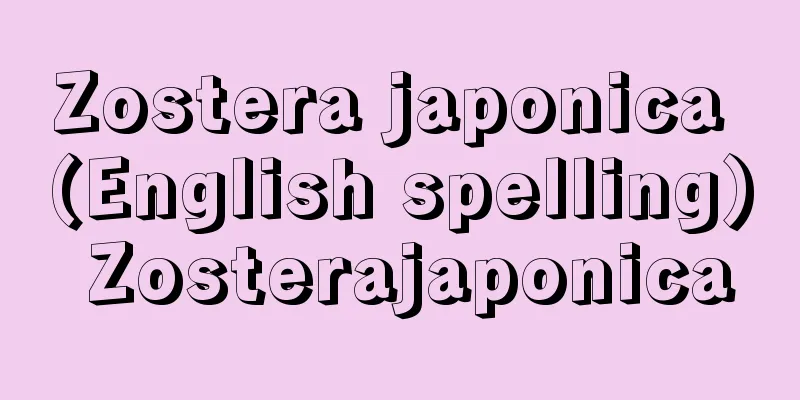Funeral group - Soushikigumi

|
A group of families that help each other out during funerals. They are called by various names depending on the region, such as Fukushigumi, Mujoko, Dogyo, Kouchi, and Kenyaku. They are religious groups such as Nembutsuko and Koshinko that have changed their focus to mutual assistance during funerals, or they are groups that separated from the "muragumi" (village group) that is a group of neighbors that help out in the area to regulate the number of people who can help out at funerals. Originally, private funeral procedures, which were centered on burial, were complicated and required a large number of people to help out. Moreover, the family and relatives who are the main players in carrying out the funeral are not able to actually take care of or work at the funeral because of the taboo. The burial procedures (field work), procuring funeral equipment, entertaining mourners, preparing meals (indoor work), etc. are mainly handled by blood relatives, branch families, and neighboring houses, and since burials and chores require a lot of labor in particular, a larger group of people can be formed with the cooperation of several neighboring houses. The funeral group was a group of cooperatives that defined the outer limits of such labor procurement, and the members of the ko-ko and accompanying shu who were bound by the Nembutsu faith naturally took on this role (attending the burial). In Nagano Prefecture, the Koshin-ko was an example of this, and the Mujo-ko in the Iwaki region of Fukushima Prefecture is another example. Originally, the cooperation in funerals was one of the important functions of the "village" community, and there were certain mutual aid regulations in every place, and it was rather common for all households in small "villages" to cooperate, and for the "village group" within a large "village". Many of the funeral groups and misfortune groups were formed by organizing groups that were later divided in order to regulate the number of people who could cooperate, and the names are mainly used according to these groups. [Toshimi Takeuchi] Source: Shogakukan Encyclopedia Nipponica About Encyclopedia Nipponica Information | Legend |
|
葬儀の際の互助手伝いにあたる家仲間。不幸組、無常講、同行、講内、契約など地方によって呼び名もいろいろで、念仏講、庚申(こうしん)講などの信仰仲間が葬儀の互助協力を主とする形に転じたもの、あるいは「むら」集団自体やその内部の近隣互助仲間である「村組」から、葬儀手伝い人員規制のため分化した形など、その成り立ちも多様である。本来土葬を主とした民間の葬送手続は複雑で多数の合力を必要とした。しかも葬儀執行の主役である家族・親族関係者は「忌み」のためもあって、葬儀執行の実際上の世話役や働き手にはなりえない。埋葬の手続(野働き)や葬具調達、弔客接待、食事調製など(内働き)の部分は、血縁の薄い本・分家や近隣の家々が主体となり、とくに埋葬や下働きにはさらに多数の労力が要るので、近隣数戸の協力によりさらに大きな合力仲間ができる。葬式組はこうした労力調達の外延を画する協力仲間で、念仏信仰に結ばれる講仲間・同行衆がおのずからその部分(埋葬立会い)を受け持つ形にもなった。長野県などでは庚申講がそれにあたり、福島県磐城(いわき)地方の無常講などもその類(たぐい)である。もともと葬儀の合力は「むら」集団の重要な機能の一つで、どこでも一定の互助規制があり、小規模の「むら」では全戸、大規模の「むら」ではその内部の「村組」単位に行う形がむしろ一般的であった。葬式組、不幸組の多くはこうした合力人数を規制するため、のちに分割した仲間を編成することで生じ、その呼び名もおもにこうした仲間に即して用いられている。 [竹内利美] 出典 小学館 日本大百科全書(ニッポニカ)日本大百科全書(ニッポニカ)について 情報 | 凡例 |
Recommend
Nuts - NATS (English spelling) nuts
It refers to nuts enclosed in a shell, but in a b...
Kagosaka Pass - Kagosaka Pass
A pass on the border between Yamanakako Village, Y...
Kitwe (English spelling)
A city in the copper-producing region of Zambia i...
Ligustrum japonicum (Ligustrum japonicum)
An evergreen shrub of the Oleaceae family, also kn...
Ulugh Muhammed - Urugumuhammed
…One of the successor states to the Kipchak Khana...
Tirich Mir (mountain)
It is the highest peak in the Hindu Kush mountain ...
Giant Clam
…They are hermaphrodites, but when they are small...
phyllosilicate
...This is the reason why cleavage parallel to th...
ocak
...Turkmen maintained a relatively good tribal or...
Ikuhomon-in
The first princess of Emperor Shirakawa. Her give...
Heliolites
…They are known from the Ordovician to the Permia...
Roverbal, GP (English) RoverbalGP
... The basis of the scales we use today, other t...
Ophiostoma
…Most of the ascus shells are ovoid and easy to i...
Josetsu - Josetsu
Years of birth and death unknown. A painter-monk ...
Kaiwajo - Kaiwajo
The person with the highest authority as a precept...


![Shiwahime [town] - Shiwahime](/upload/images/67cbe76421bec.webp)






